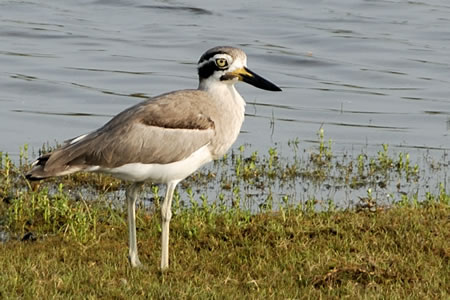

| Bird watching in Bundala National Park | |
Mirissa Beach (Sri Lanka), February 17th 2011 |
|
The day of our morning safari to Bundala National Park starts on the driveway of Independent Travellers Inn; an empty driveway! We agreed with the owner of the Independent Travellers Inn that we would leave today on 05:30 with a certain jeep to Bundala National Park. However, at the agreed time the jeep isn’t there and there isn’t even a trace of the owner. Because of the limited notion of exactness in this part of the world, we try to stay patient. Fifteen minutes later, the owner of the hotel arrives with an inferior jeep. The jeep is much lower, which makes it impossible for Edwin to stand upright. In the end, we decide to take it the way it is. The early bird catches the worm, and because we already lost valuable time, we don’t want to lose more of the most productive birding hours of the day. |
|
 |
|
Our jeep for the Bundala dafari |
|
At the entrance of both parks, every jeep should get an “animal tracker” to help you find the animals that you hope to see. This animal tracker is included in the entrance fee and for Bundala there are enough trackers for the amount of visitors that come to the park. In Yala, you really need to ask for an animal tracker, as during the high season there is only one tracker available for every ten jeeps. To be on the safe side, we also asked specifically for an animal tracker in Bundala, as we know how important it is to have a pair of well trained eyes with you when you want to see wildlife. The employee of the ticket counter roars with laughter when he hears our request for the animal tracker. “You aren’t here to see animals; you are here to see birds!” We have never known that a bird isn’t an animal, but we don’t start that discussion. A few minutes later we enter with our jeep and our “bird tracker” the national park. Contrary with many other wetland parks, you visit Bundala by jeep instead of boat. Jeep tracks cross the relatively small park, which makes it possible to get close to the lakes and mudflats to see the birds. Luckily, the birds aren’t bothered by the noise of the jeeps. |
|
 |
|
The Great Thick-knee shows himself well |
|
| We dressed ourselves this morning in our dark bird watching outfit, but when we see the flashy pink T-shirt of our bird tracker, we feel a bit overdressed. Our first impression is that our tracker is an uninterested amateur, but we are completely wrong. This bird tracker really seems to know what he is doing; he knows that the birds aren’t scared away by the colour of his shirt. The birds are relatively tame and can be observed from a close distance. Due to the similarity of many water bird species, we always have some difficulty to determine which specie a certain bird is. Our tracker doesn’t only tell us the name of the specie, but he also explains what the differences are to look for. The diversity of birds within the park is huge. In every small lake, there are at least 10 species. We can imagine that even people who are only slightly interested in birds, will enjoy a morning safari in Bundala National Park, as there are many spectacular species that will probably be appreciated by everybody who sees them. Colourful Painted Storks are often only a few metres from you jeep as well as the Asian Openbills, Spot-billed Pelicans and Black-headed Ibises. The park is also the home of a small herd of elephants, which seem to be rather easily spotted in the afternoon. However, we are here during the morning hours, so we don’t expect to see those giants.
We stay a little bit more than three hours in the park and we see 67 species of birds. We are very happy that we finally saw the Eurasian and Great Thick-knee very well, as they were high on our “want to see list”. These cartoonlike birds with beautiful coloured markings and heavy bills are a pleasure to see. On our way back to the entrance, our bird tracker yells that the driver has to stop. In the bushes, he spotted an elephant that was feeding himself with some fresh leaves and branches. This is a great way to end our trip to Bundala National Park. Luckily, our “bird tracker” also seems to be a very good “animal tracker”. © copyright - Babakoto.eu / 2011 |
|